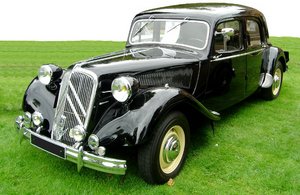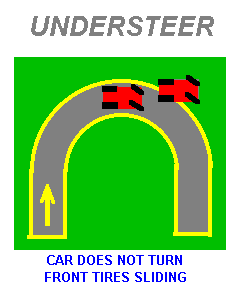Front Wheel Drive
The most common style of drive train is that of the front wheel drive,
abbreviated FWD. Front wheel drive was not, however, the first drive system.
Front wheel drive first  made its appearance in the automobile market in 1933 with the French Traction
Avant, which literally means "pull from the front." At the time, the idea of
having a car pulled by the front wheels was rather different, but this style of
getting the power to the wheels worked rather well. What made the Traction
Avant successful was that it was lighter and more fuel efficient than other car
models made at the time. This increased efficiency was a result of not only
eliminated weight, but also reduced power loss in moving the rotational energy
to the back.
made its appearance in the automobile market in 1933 with the French Traction
Avant, which literally means "pull from the front." At the time, the idea of
having a car pulled by the front wheels was rather different, but this style of
getting the power to the wheels worked rather well. What made the Traction
Avant successful was that it was lighter and more fuel efficient than other car
models made at the time. This increased efficiency was a result of not only
eliminated weight, but also reduced power loss in moving the rotational energy
to the back.
The idea of front wheel driven cars was not embraced immediately by major car
manufacturers, though, since  having all the driving mechanisms placed right under or in front of the engine
added complexity in production and maintenance that was not worth the extra gas
mileage. It was when the gasoline shortage hit America in the early 1980s that
the front wheel drive car first became popular. Chevrolet first implemented the
system in its "Citation," in 1979, which became an affordable yet popular
compact car. Ford soon followed suit with its larger Taurus, and thus sparked
the trend of front wheel drive systems being common among the domestic cars
manufactured today.
having all the driving mechanisms placed right under or in front of the engine
added complexity in production and maintenance that was not worth the extra gas
mileage. It was when the gasoline shortage hit America in the early 1980s that
the front wheel drive car first became popular. Chevrolet first implemented the
system in its "Citation," in 1979, which became an affordable yet popular
compact car. Ford soon followed suit with its larger Taurus, and thus sparked
the trend of front wheel drive systems being common among the domestic cars
manufactured today.
Among car enthusiasts, front wheel drive is often seen as a poor drive system.
Since both the power and the steering are both done by the front tires, there
is a tendency for a front wheel drive car to lose its ability to steer if the
car is either spinning its tires or corners at too high a speed, also known as
under-steering. Also, by having all of the mechanisms, or differential, of a
car in the front, an issue of weight balance is inherently present. This often
leads to under-steer as well, as the rear-end often weighs much less than the
front and thus has less relative momentum, leading to the front tires breaking
loose first when driving around a corner. None of these problems exist in
rear wheel drive cars.
<- Introduction
Rear Wheel Drive ->
Russell Gillmore 2004 F03
 made its appearance in the automobile market in 1933 with the French Traction
Avant, which literally means "pull from the front." At the time, the idea of
having a car pulled by the front wheels was rather different, but this style of
getting the power to the wheels worked rather well. What made the Traction
Avant successful was that it was lighter and more fuel efficient than other car
models made at the time. This increased efficiency was a result of not only
eliminated weight, but also reduced power loss in moving the rotational energy
to the back.
made its appearance in the automobile market in 1933 with the French Traction
Avant, which literally means "pull from the front." At the time, the idea of
having a car pulled by the front wheels was rather different, but this style of
getting the power to the wheels worked rather well. What made the Traction
Avant successful was that it was lighter and more fuel efficient than other car
models made at the time. This increased efficiency was a result of not only
eliminated weight, but also reduced power loss in moving the rotational energy
to the back.
 having all the driving mechanisms placed right under or in front of the engine
added complexity in production and maintenance that was not worth the extra gas
mileage. It was when the gasoline shortage hit America in the early 1980s that
the front wheel drive car first became popular. Chevrolet first implemented the
system in its "Citation," in 1979, which became an affordable yet popular
compact car. Ford soon followed suit with its larger Taurus, and thus sparked
the trend of front wheel drive systems being common among the domestic cars
manufactured today.
having all the driving mechanisms placed right under or in front of the engine
added complexity in production and maintenance that was not worth the extra gas
mileage. It was when the gasoline shortage hit America in the early 1980s that
the front wheel drive car first became popular. Chevrolet first implemented the
system in its "Citation," in 1979, which became an affordable yet popular
compact car. Ford soon followed suit with its larger Taurus, and thus sparked
the trend of front wheel drive systems being common among the domestic cars
manufactured today.